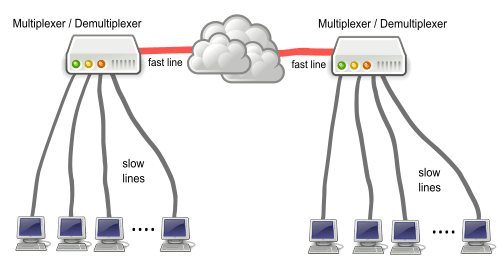Multiplexing facts for kids
Multiplexing is a clever way to send many different messages or signals at the same time over one connection. Imagine lots of people wanting to talk on the same phone line. Multiplexing helps combine all their voices into one stream. Then, at the other end, a "demultiplexer" separates them back into their original messages. This makes communication much more efficient!
Multiplexing was first used for sending telegraph messages in the 1870s. It was later used for telephone lines starting in 1910. Today, multiplexing is used everywhere, from your internet connection to radio and TV broadcasts.
Contents
How Does Multiplexing Work?
There are different ways to combine signals using multiplexing. Each method helps keep the different messages from getting mixed up.
Space Division Multiplexing
This method is like having many different paths or spaces for each signal. Each signal gets its own exclusive area. Think of it like people talking in different rooms in a big house. If the rooms are far enough apart, the conversations won't bother each other. This is a simple way to keep signals separate.
Frequency Division Multiplexing
With this method, different signals use different frequencies. Imagine a radio station. Each station broadcasts on its own unique frequency. This means you can listen to one station without hearing another one at the same time. Animals like bats use very high frequencies that humans cannot hear. Their sounds do not interfere with our conversations because they are on different frequencies.
Time Division Multiplexing
This method gives each signal a short turn to use the connection. It's like people taking turns to speak. Only one person speaks at a time, but they speak very quickly. In Amateur radio, only one person can talk on a channel at any given moment. Different people who speak at different times do not interfere with each other. The system quickly switches between signals, so it feels like they are all happening at once.
Code Division Multiplexing
In this method, each signal is given a special code. Different signals use different codes. Think of it like people speaking different languages. If you only understand English, you won't understand someone speaking French. This way, many signals can be sent at the same time over the same connection. Each receiver only listens for the signal with its specific code.
Images for kids
See also
 In Spanish: Multiplexación para niños
In Spanish: Multiplexación para niños


